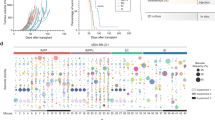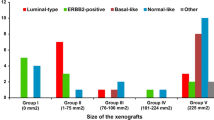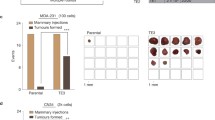Abstract
In vivo models utilizing orthotopic injection of tumor cells into nude mice have proven valuable for the study of metastasis. However, breast cancers are among the more difficult of human tumors to grow in immunodeficient mice, with a relatively low tumor take. Fewer still develop spontaneous metastases. The injection of GI101A breast cancer cells into the mammary fatpad (mfp) produced lung metastases in 25% of tumor-bearing mice. Selecting cells from the lung metastases and recycling in vivo resulted in the isolation of a series of variant cell lines. These cell lines were tested for tumorigenicity and metastasis in nude mice following mfp injection compared with the original cell line, and in vitro expression of factors associated with the metastatic phenotype measured. The in vivo selected cell lines were more aggressive, with higher tumor take, faster local growth rate and increased incidence (≥85%) and extent of lung metastasis. However, the metastasis-selected variants showed no increases in expression of the growth factor receptors EGFR or HER-2, and the pro-angiogenic factors VEGF-A and IL-8. Immunohistochemistry of mfp tumors revealed no differences in microvessel density (counting CD-31 positive structures) and cell proliferation (PCNA-positive cells) comparing the GI101A line with selected variants. No TUNEL-positive cells were detected in the tumors of the metastasis-derived variant, with a small number of cells undergoing apoptosis detected in sections of GI101A tumors. In vitro, the metastasis-derived variants were found to have a more robust expression of phosphorylated PKB/Akt, with or without EGF or serum stimulation, suggesting an association between Akt activation and metastatic ability. This new series of isogenic cell lines may be valuable for identifying molecular mechanisms involved in the metastatic progression of breast cancer.
Similar content being viewed by others
References
Hortobagyi GN, Hung MC, Buzdar AU. Recent developments in breast cancer therapy. Semin Oncol 1999; 26: 11–20.
Hagemeister FB, Buzdar AV, Luna MA, Blumenschein M. Causes of death in breast cancer: A clinicopathological study. Cancer 1980; 46: 162–7.
Fidler IJ. Critical factors in the biology of human cancer metastasis: Twenty-eighth G.H.A. Clowes Memorial Award Lecture. Cancer Res 1990; 50: 6130–8.
Liotta LA, Kohn EA. The microenvironment of the tumour-host interface. Nature 2001; 411: 375–9.
Park CC, Bissell MJ, Barcellos-Hoff MH. The influence of the microenvironment on the malignant phenotype. Mol Med Today 2000; 6: 324–9.
Miller FR, Miller BE, Heppner GH. Characterization of metastatic heterogeneity among subpopulations of a single mouse mammary tumor: heterogeneity in phenotypic stability. Invasion Metastasis 1983; 3: 22–31.
Price JE, Aukerman SL, Fidler IJ. Evidence that the process of murine melanoma metastasis is sequential and selective and contains stochastic elements. Cancer Res 1986; 46(10): 5172–8.
Heppner GH. Cancer cell societies and tumor progression. Stem Cells 1993; 11: 199–203.
Herzig M, Christofori G. Recent advances in cancer research: Mouse models of tumorigenesis. Biochim Biophys Acta 2002; 1602: 97–113.
Foulds L. Neoplastic Development. London: Academic Press 1975.
Hutchinson JN, Muller WJ. Transgenic mouse models of human breast cancer. Oncogene 2000; 19: 6130–7.
Nicolson GL, Lembo TM, Welch DR. Growth of rat mammary adenocarcinoma cells in semisolid clonogenic medium not correlated with spontaneous metastatic behavior: Heterogeneity in the metastatic, antigenic, enzymatic, and drug sensitivity properties of cells from different sized colonies. Cancer Res 1988; 48: 399–404.
Fogh J, Fogh JM, Orfeo T. One hundred and twenty-seven cultured human tumor cell lines producing tumors in nude mice. J Natl Cancer Inst 1977; 59: 221–5.
Price JE, Polyzos A, Z hang RD, Daniels LM. Tumorigenicity and metastasis of human breast carcinoma cell lines in nude mice. Cancer Res 1990; 50: 717–21.
Price JE. Metastasis from human breast cancer cell lines. Breast Cancer Res Treat 1996; 39(1): 93–102.
Hurst J, Maniar N, Tombarkiewicz J, et al. A novel model of a metastatic human breast tumour xenograft line. Br J Cancer 1993; 68: 274–6.
Yoneda J, Kuniyasu H, Crispens MA et al. Expression of angiogenesis-related genes and progression of human ovarian carcinomas in nude mice. J Natl Cancer Inst 1998; 90: 447–54.
Radinsky R, Fidler IJ, Price JE et al. Terminal differentiation and apoptosis in experimental lung metastases of human osteogenic sarcoma cells by wild type p53. Oncogene 1994; 9(7): 1877–83.
Lu Y, Lin Y-Z, LaPushin R et al. The PTEN/MMAC1/TEP tumor suppressor gene decreases cell growth and induces apoptosis and anoikis in breast cancer cells. Oncogene 1999; 18: 7034–45.
Paget S. The distribution of secondary growths in cancer of the breast. Lancet 1889; i: 571–3.
Folkman J, Klagsbrun M. Angiogenic factors. Science 1987; 235: 442–7.
Weidner N, Semple JP, Welch WR, Folkman J. Tumor angiogenesis and metastasis-correlation in invasive breast carcinoma. N Engl J Med 1991; 324: 1–8.
Ellis LM, Fidler IJ. Angiogenesis and metastasis. Eur J Cancer 1996; 32A: 2451–60.
Gasparini G. Clinical significance of determination of surrogate markers of angiogenesis in breast cancer. Crit Rev Oncol/Hematol 2001; 37: 97–114.
Toi M, Inada K, Hoshina S et al. Vascular endothelial growth factor and platelet-derived endothelial cell growth factor are frequently coexpressed in highly vascularized human breast cancer. Clin Cancer Res 1995; 1: 961–4.
De Larco JE, Wuertz BRK, Rosner KA et al. A potential role for interleukin-8 in the metastatic phenotype of breast carcinoma cells. Am J Pathol 2001; 158(2): 639–46.
Marshall LJ, Perks B, Ferkol T, Shute JK. IL-8 released constitutively by primary bronchial epithelial cells in culutre forms an inactive complex with secretory component. J Immunol 2001; 167: 2816–23.
Kanayama H, Yano S, Kim SJ et al. Expression of vascular endothelial growth factor by human renal cancer cells enhances angiogenesis of primary tumors and production of ascites but not metastasis to the lungs of nude mice. Clin Exp Metastasis 1999; 17: 831–40.
Chambers AF, Matrisian LM. Changing views of the role of matrix metalloproteinases in metastasis. J Natl Cancer Inst 1997; 89: 1260–70.
Heppner KJ, Matrisian LM, Jensen RA, Rodgers WH. Expression of most matrix metalloproteinase family members in breast cancer represents a tumor-induced host reponse. Am J Pathol 1996; 149: 273–82.
Sun J, Hemler ME. Regulation of MMP-1 and MMP-2 production through CD147/extracellular matrix metalloproteinase inducer interactions. Cancer Res 2001; 61: 2276–81.
Egeblad M, Werb Z. New functions for the matrix metalloproteinases in cancer progression. Nature Rev Cancer 2002; 2: 161–74.
Testa JR, Bellacosa A. AKT plays a central role in tumorigenesis. Proc Natl Acad Sci USA 2001; 98: 10983–5.
Liaw D, Marsh DJ, Li J et al. Germline mutations of the PTEN gene in Cowden disease, an inherited breast and thyroid cancer syndrome. Nat Genet 1997; 16(1): 64–7.
Datta SR, Brunet A, Greenberg ME. Cellular survival: A play in three Akts. Genes Dev 1999; 13: 2905–27.
Nakanishi K, Sakamoto M, Yasuda J et al. Critical involvement of the phosphatidylinositol 3-kinase/Akt pathway in anchorage-independent growth and hematogenous intrahepatic metastasis of liver cancer. Cancer Res 2002; 62: 2971–5.
Itoh N, Semba S, Ito M et al. Phosphorylation of Akt/PKB is required for suppression of cancer cell apoptosis and tumor progression in human colorectal carcinoma. Cancer 2002; 94: 3127–34.
Perez-Tenorio G, Stal O, Arnesson LG et al. Activation of AKT/PKB in breast cancer predicts a worse outcome amoung endocrine treated patients. Br J Cancer 2002; 86: 540–5.
Hermanto U, Zong CS, Wang LH. ErbB2-overexpressing human mammary carcinoma cells display an increased requirement for the phosphatidylinositol 3-kinase signaling pathway in anchorageindependent growth. Oncogene 2001; 20: 7551–62.
Slamon DJ. Human breast cancer: correlation of relapse and survival with amplification of the HER-2/neu oncogene. Science 1987; 235: 177–82.
Gasparini G, Pozza F, Harris AL. Evaluating the potential usefulness of new prognostic and predictive indicators in node-negative breast cancer patients. J Natl Cancer Inst 1993; 85: 1206–19.
Author information
Authors and Affiliations
Corresponding author
Rights and permissions
About this article
Cite this article
Chelouche Lev, D., Kiriakova, G. & Price, J.E. Selection of more aggressive variants of the GI101A human breast cancer cell line: A model for analyzing the metastatic phenotype of breast cancer. Clin Exp Metastasis 20, 515–523 (2003). https://doi.org/10.1023/A:1025837631179
Issue Date:
DOI: https://doi.org/10.1023/A:1025837631179




